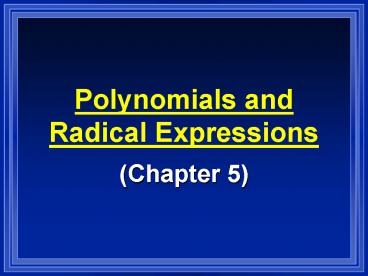Polynomials and Radical Expressions - PowerPoint PPT Presentation
1 / 18
Title: Polynomials and Radical Expressions
1
Polynomials and Radical Expressions
- (Chapter 5)
2
Properties of Exponents
- am . an a(m n)
- am / an a(m ? n)
- (am)n a(m?n)
- (a ? b)m am ? bm
- (a / b)m am / bm
- a0 1
3
Negative Exponents
- a-n 1 and 1 an an a-n
- Scientific Notation
- a x 10n
- where 1 lt a lt 10 and n is an integer.
4
Monomials (5.1)
- monomial an expression that is a number, a
variable, or the product of a number and one or
more variables. - constant a monomial that contains no variables.
5
- coefficient the number part of a monomial.
- degree (of a monomial) the sum of the exponents
of the variables. - 3 is a constant (degree of 0).
- 3x2 has a degree of 2.
- 3x2y4z5 has a degree of 11.
6
- Variables in monomials must have whole number
exponents. - If a variable is under a radical sign or in a
denominator, then it is not a monomial. - and 1/x2 are not monomials.
7
Polynomials (5.3)
- polynomial a monomial or a sum of monomials.
- terms the monomials that make up a polynomial.
- like terms terms with the same variables with
the same exponents.
8
- binomial a polynomial with two unlike terms.
- trinomial a polynomial with three unlike terms.
- degree (of a polynomial) the degree of its
largest monomial.
9
Adding Polynomials
- To add polynomials, add like terms.
- To subtract polynomials, subtract like terms, or
- distribute the negative into the second
polynomial and then add like terms.
10
Multiplying Polynomials
- To multiply monomials, multiply the coefficients
and follow the exponent rules for the variables. - To multiply two binomials together, use F.O.I.L.
- To multiply larger polynomials, use M.E.T.W.E.T.
11
Dividing Polynomials (5.3)
- To divide a polynomial by a monomial, divide each
term by the monomial. - To divide a polynomial by another polynomial,
use long division. - (D.M.S.B.R.)
12
- To divide a polynomial by a first-degree
binomial, use synthetic division. - Write the coefficients in a row (in descending
order). - Write the opposite of the constant of the divisor
to the left. - Bring down the first number.
13
- Multiply the number with the constant.
- Add the product with the next coefficient.
- Repeat steps 4 and 5 until there are no more
numbers. - Write the last answer as a remainder.
14
- If the divisor has a leading coefficient other
than 1, that must be divided separately. - Divide it out of the divisor first.
- Do the synthetic division.
- Then divide it out of the final answer.
15
Factoring (5.4)
- factors (of a polynomial) polynomials that
divide evenly into a polynomial. - prime polynomials polynomials that cannot be
factored.
16
Types of Factoring
- Common factors
- Difference of Squares
- Difference of Cubes
- Sum of Cubes
- Perfect Square Trinomials
- Guess and Check
- Grouping (for 4 or more terms)
17
Graphs of Polynomial Functions (5.2)
- A polynomial function cannot have
- Negative exponents on the variables
- Variables in the denominator
- Fractional exponents on the variables
- Variables in a radicand
18
End Behavior of Polynomials
- To determine the shape of a graph of a polynomial
function, look at its leading coefficient and its
degree. - PEHH POLH NELL NOHL
- (The x-intercepts and y-intercept will also be
important in graphing polynomial functions.)































